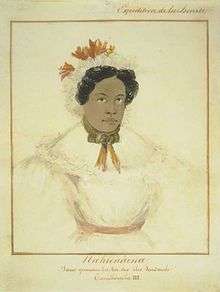Nahienaena
| Nāhiʻenaʻena | |||||
|---|---|---|---|---|---|
 Painting of Nāhiʻenaʻena by Barthélémy Lauvergne in 1836. | |||||
| Born |
c. 1815 Keauhou Bay at South Kona, Hawaiʻi | ||||
| Died |
December 30, 1836 Honolulu, Oahu | ||||
| Burial |
Mokuʻula then Waiola Church | ||||
| Spouse |
Kamehameha III (uncanonical) William Pitt Leleiohoku I | ||||
| Issue |
Keiki Lot Kapuāiwa (hānai) | ||||
| |||||
| House | House of Kamehameha | ||||
| Father | Kamehameha I | ||||
| Mother | Queen Keōpūolani | ||||
Harriet or Harrieta Keōpūolani Nāhiʻenaʻena (1815–1836) was a high-ranking princess during the founding of the Kingdom of Hawaii and the conversion of some of the ruling class to Christianity.
Life
In the Hawaiian language nā ahi ʻena ʻena means "the red-hot raging fires".[1][2]
She was born in 1815 at Keauhou Bay, South Kona, island of Hawaiʻi. Her parents were Kamehameha I and Keōpūolani the Queen consort.[3] She had two older brothers, hiapo (first born) Liholiho, and Kauikeaouli, who were to become Kings Kamehameha II and III. This sacred muli loa (last born) child was trained for the immense kuleana (privilege and responsibility) that would accompany someone of such high birth.[4]
In 1825, the ship HMS Blonde returned with the bodies of King Kamehameha II and the Queen Kamāmalu who had died on a trip to London. Ship's artist Robert Dampier painted a portrait of the ten-year-old princess, dressed in a red feather cloak for the state funeral.[5]
She was in love with her brother Kamehameha III [6] and the old chiefs strongly encouraged their marriage, but the missionaries were opposed to the union, calling it incest and therefore a sin. The practice of marriage between siblings in the royal family was considered a way of keeping the bloodlines pure in ancient Hawaii. Nāhiʻenaʻena's own maternal grandparents were half sister and brother.
Princess Nāhiʻenaʻena had been affected by the conflicts of Christianity and her culture causing her to embrace both beliefs. She would follow cultural traditions such as Hula, but also drink rum just as the missionaries did.[7] She showed rebellion and distaste for many Christian tasks.[8] She would interrupt church services and openly defy missionary teachings.[8] Although she and many others were fragmented on beliefs, she never fully converted. On her death bead, missionary wives tried to urge her to repent for her sins.[7] She may have been fighting to stay embedded with her Hawaiian culture.
She was eventually betrothed to William Pitt Leleiohoku I, the son of William Pitt Kalanimoku Prime Minister of Hawaii. Kamehameha III tried to delay the wedding by insisting Leleiohoku be educated first. Leleiohoku and Nāhiʻenaʻena were married November 25, 1835 by William Richards at Waineʻe Church.[9]:340
In September 17, 1836 she gave birth to a child. Kamehameha III announced that the child would be the heir to the throne because he believed it to be his, but the child lived for only a few hours.[5] Nāhiʻenaʻena never recovered physically or emotionally from the birth of her child. British physician Thomas Charles Byde Rooke, the husband of High Chiefess Grace Kamaʻikuʻi, examined her but was unable to determine the cause of the illness. He called upon Dr. Ruschenberger, a visiting surgeon, to assist him. Nāhiʻenaʻena died on December 30, 1836, near Hale Uluhe, the home of her brother, Kamehameha III. After nearly five weeks of intense grieving, her body was brought in procession to Kawaiahaʻo Church for funeral services. The procession was led by traditional warriors and kāhuna laʻau lapaʻau (healers).[10] On April 12, 1837 her body was brought aboard the ship Don Qixote (purchased and renamed Kai Keōpūolani by her brother), to the sacred resting place called Mokuʻula in Lāhainā, Maui to be buried next to her mother Keōpūolani.
Her death had a sobering effect on her brother, King Kamehameha III.[5]:37
Ancestry
| Ancestors of Nahienaena | ||||||||||||||||||||||||||||||||||||||||||||||||||||||||||||||||||||||||||||||||||||||||||||||||||||||||||||||||||||||||||||||||||||||||||||||||||||||||||||||||||||||||||||||||||||||||||||||||||||||||||||||||||||||||||||||||||||||||||||||||||||||||||||||||||||||||||||||||||||||||||||||||||||||||||||||||||||||||||||||||||||||||||||||||||||||||||||||||||||||||||||||||||||||||||||||||||||||||||||||||||||||||||||||||||||||||||||||||||||||||||||||||||||||||||||||||||||||||||||||||||||||||||||||||||||||||||||||||||
|---|---|---|---|---|---|---|---|---|---|---|---|---|---|---|---|---|---|---|---|---|---|---|---|---|---|---|---|---|---|---|---|---|---|---|---|---|---|---|---|---|---|---|---|---|---|---|---|---|---|---|---|---|---|---|---|---|---|---|---|---|---|---|---|---|---|---|---|---|---|---|---|---|---|---|---|---|---|---|---|---|---|---|---|---|---|---|---|---|---|---|---|---|---|---|---|---|---|---|---|---|---|---|---|---|---|---|---|---|---|---|---|---|---|---|---|---|---|---|---|---|---|---|---|---|---|---|---|---|---|---|---|---|---|---|---|---|---|---|---|---|---|---|---|---|---|---|---|---|---|---|---|---|---|---|---|---|---|---|---|---|---|---|---|---|---|---|---|---|---|---|---|---|---|---|---|---|---|---|---|---|---|---|---|---|---|---|---|---|---|---|---|---|---|---|---|---|---|---|---|---|---|---|---|---|---|---|---|---|---|---|---|---|---|---|---|---|---|---|---|---|---|---|---|---|---|---|---|---|---|---|---|---|---|---|---|---|---|---|---|---|---|---|---|---|---|---|---|---|---|---|---|---|---|---|---|---|---|---|---|---|---|---|---|---|---|---|---|---|---|---|---|---|---|---|---|---|---|---|---|---|---|---|---|---|---|---|---|---|---|---|---|---|---|---|---|---|---|---|---|---|---|---|---|---|---|---|---|---|---|---|---|---|---|---|---|---|---|---|---|---|---|---|---|---|---|---|---|---|---|---|---|---|---|---|---|---|---|---|---|---|---|---|---|---|---|---|---|---|---|---|---|---|---|---|---|---|---|---|---|---|---|---|---|---|---|---|---|---|---|---|---|---|---|---|---|---|---|---|---|---|---|---|---|---|---|---|---|---|---|---|---|---|---|---|---|---|---|---|---|---|---|---|---|---|---|---|---|---|---|---|---|---|---|---|---|---|---|---|---|---|---|---|---|---|---|---|---|---|---|---|---|---|---|---|---|---|---|---|---|---|---|---|---|---|---|---|---|---|---|---|---|---|---|---|---|---|---|---|---|---|---|---|---|---|---|---|---|---|---|---|---|---|---|---|---|---|---|---|---|---|---|---|---|---|---|---|---|---|---|---|---|---|---|---|---|---|---|---|---|---|---|---|---|---|---|---|---|---|---|---|---|---|---|---|
| ||||||||||||||||||||||||||||||||||||||||||||||||||||||||||||||||||||||||||||||||||||||||||||||||||||||||||||||||||||||||||||||||||||||||||||||||||||||||||||||||||||||||||||||||||||||||||||||||||||||||||||||||||||||||||||||||||||||||||||||||||||||||||||||||||||||||||||||||||||||||||||||||||||||||||||||||||||||||||||||||||||||||||||||||||||||||||||||||||||||||||||||||||||||||||||||||||||||||||||||||||||||||||||||||||||||||||||||||||||||||||||||||||||||||||||||||||||||||||||||||||||||||||||||||||||||||||||||||||
See also
References
- ↑ Pukui and Elbert (2003). "lookup of Nāhi". on Hawaiian dictionary. Ulukau, the Hawaiian Electronic Library, University of Hawaii. Retrieved 2009-12-30.
- ↑ Pukui and Elbert (2003). "lookup of 'ena'ena". on Hawaiian dictionary. Ulukau, the Hawaiian Electronic Library, University of Hawaii. Retrieved 2009-12-30.
- ↑ Royal Ark
- ↑ Kamakau S.M. Ke Aupuni Mōʻī. Kamehameha Schools Press 2001
- 1 2 3 Marjorie Sinclair (1969). "Princess Nahienaena". Hawaiian Historical Society. Hawaiian Historical Society. 3: 3–30. hdl:10524/247.
- ↑ Haley, James L., Captive Paradise: A History of Hawaii p. 78, 2014, ISBN 978-0-312-60065-5
- 1 2 Heck, Maenette Kape'ahiokalani Padeken Ah Nee Benham ; Ronald H. (1998). Culture and educational policy in Hawai'i : the silencing of native voices. Mahwah, NJ u.a.: Erlbaum. p. 32. ISBN 0-8058-2704-8.
- 1 2 Sinclair, Marjorie (1976). Nāhiʻenaʻena, sacred daughter of Hawaiʻi. Honolulu: University Press of Hawaii. p. 146. ISBN 0-8248-0367-1.
- ↑ Kamakau, Samuel (1992) [1961]. Ruling Chiefs of Hawaii (Revised ed.). Honolulu: Kamehameha Schools Press. ISBN 0-87336-014-1.
- ↑ Ke Kumu. 15 February 1837. Honolulu
Further reading
- Marjorie Jane Putnam Sinclair (1976). Nahiʻenaʻena, Sacred Daughter of Hawaii. University Press of Hawaii. ISBN 978-0-8248-0367-4.
External links
| Wikimedia Commons has media related to Nāhienaena. |
%2C_Nahiennaena_(1825).jpg)